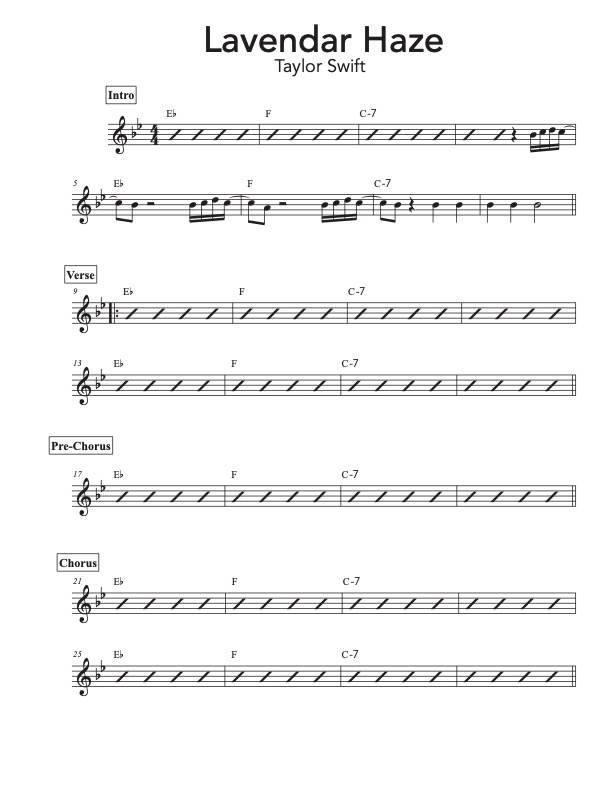Lavender Haze | Taylor Swift Leadsheet

Lavender Haze is the opening track on Taylor Swift's 10th studio album: "Midnights." From the first moment the synths come in, you can hear that Taylor has turned a corner musically.
Not unlike many of the tracks on Midnights, Lavender Haze technically only has 4 chords, giving it a more modern and loopy feel. This is relatively new for Taylor, but is not uncommon for pop music over the last decade.
What Key is Lavender Haze in?
From the vibe of this song, it seems that Lavender Haze is actually in C Dorian! This shares a key signature with Bb Major (B flat major). Listening to the song, you'd probably agree that the feeling isn't major, which would lead you to assume that it's in G minor (the relative minor of Bb major), but that doesn't seem quite right either - especially since there's not a single G minor chord in the entire song. But every phrase ends in a C minor chord, making the ear feel that as the tonal center.
Assuming that Lavender Haze is in C Dorian, the analysis for the chords goes like this:
bIII IV I-7
These are actually important chords within the dorian mode (link to dorian article), making it seem like this is in Dorian.
Is Lavender Haze Dorian?
One way you can tell quickly whether a song is, for instance, in major or its relative minor is to take a look at the final chord of the song to see how the whole thing resolves. Here's the weird thing about Lavender Haze - it doesn't really resolve. The last measure of the song is just vocals, with no chord underneath. As much as the vocals (and the pattern that we got used to in the song) are hinting at a C minor chord, the lack of chord there makes it feel super ambiguous. But dorian is pretty ambiguous, so maybe that's even more proof.
What Song Form is Lavender Haze In
Lavender Haze is in a pretty standard pop song form: verse, pre-chorus, chorus (x2), bridge, repeat chorus
One of the most powerful elements in this song is pre-chorus. The pre-chorus uses space to build tension, taking out everything except for the kick drum and the bass, making the listener think that something's coming, then leads into the chorus with a drum fill, setting us up for the epic feeling of the chorus.
There's one measure at the end of the pre-chorus that, because of the production, actually makes it impossible to tell if it's still C minor like the chord before, or if it's anticipating the Eb major of the next bar. In this leadsheet, I wrote it as Eb, but you can also stay on C minor there.

I hope you enjoy this leadsheet! If you want to learn more about reading chord changes, make sure to sign up for our mailing list where we share lots of in-depth learning materials.f
If you're looking for piano lessons in Redmond, check out our in-home music lessons in Washington state.



